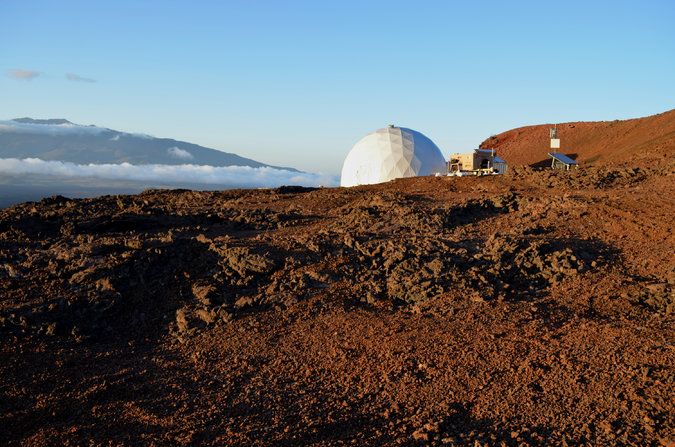On the way to Mars, Neil Scheibelhut stopped by Walmart for mouthwash and dental floss. “We’re picking up some last-minute things,” he said via cellphone last Wednesday afternoon from the store.
Mr. Scheibelhut is not actually an astronaut leaving the earth. But three hours later, he and five other people stepped into a dome-shaped building on a Hawaiian volcano where they will live for the next eight months, mimicking a stay on the surface of Mars.
This is part of a NASA-financed study, the Hawaii Space Exploration Analog and Simulation, or Hi-Seas for short. The goal is to examine how well a small group of people, isolated from civilization, can get along and work together.
When astronauts finally head toward Mars years from now — NASA has penciled the 2030s — it will be a long and lonely journey: about six months to Mars, 500 days on the planet, and then another six months home.
“Right now, the psychological risks are still not completely understood and not completely corrected for,” said Kimberly Binsted, a professor of information and computer sciences at the University of Hawaii at Manoa and the principal investigator for the project. (She is not in the dome.) “NASA is not going to go until we solve this.”
Isolation can lead to depression. Personality conflicts can spin out of control over the months.
“How do you select and support astronauts for a mission that will last two to three years in a way that will keep them healthy and performing well?” Dr. Binsted said. Or as Mr. Scheibelhut put it:
“I’m so interested to see how I react. ‘I don’t know’ is the short answer. I think it could go a lot of different ways.”
Several mock Mars missions have been conducted in recent years. A simulation in Russia in 2010 and 2011 stretched 520 days, most of the duration of an actual mission. Four of the six volunteers developed sleep disorders and became less productive as the experiment progressed. The Mars Society, a nonprofit group that promotes human spaceflight, has run short simulations in the Utah desert since 2001 and is looking to do a one-year simulation in the Canadian Arcticbeginning in 2015.
Hi-Seas has already conducted two four-month missions, and next year, six more people will reside for one year inside the dome, a two-story building 36 feet in diameter with about 1,500 square feet of space. It sits in an abandoned quarry at an altitude of 8,000 feet on Mauna Loa.
To simulate the operational challenges, the crew members in the Hi-Seas dome are largely cut off. Their communications to the world outside the dome are limited to email, and each message is delayed by 20 minutes before being sent, simulating the lag for communications to travel from Mars toEarth and vice versa.
Every time one of the would-be astronauts or mission control sends a message, at least 40 minutes will elapse before a reply arrives. Real-time conversation is impossible.
On a real mission, the lag time would often be considerably shorter as Mars and Earth moved closer together, but Dr. Binsted said, “We went with the worst case because we’re trying to solve the worst-case situation.”
Some 150 people applied to participate. Dr. Binsted said the three men and three women of this Hi-Seas crew were chosen to have a similar mix of experience and backgrounds as real NASA astronauts, and many indeed aspire to go to space.
The commander is Martha Lenio, 34, an entrepreneur looking to start a renewable-energy consulting company. Other crew members are Jocelyn Dunn, 27, a Purdue University graduate student; Sophie Milam, 26, a graduate student at the University of Idaho; Allen Mirkadyrov, 35, a NASA aerospace engineer; and Zak Wilson, 28, a mechanical engineer who worked on military drone aircraft at General Atomics in San Diego.
“I dream about being an astronaut, and this might be the closest I ever get,” Ms. Dunn said.
Mr. Wilson had previously done a two-week stay at the Mars habitat in Utah. Mr. Scheibelhut had worked on the first Hi-Seas mission as part of the ground support crew. “I thought it would be really cool to be part of what’s going on inside,” he said.
For their time, each is receiving round-trip airfare to Hawaii, a $11,500 stipend, food and, of course, lodging.
At the outset, the six appear to get along fine. “This is a fantastic group of people,” Mr. Scheibelhut said. “Right now, everything is wonderful.”
He said he recognized that there would be unpleasant patches. “Eight months — you’re going to have real conflicts you’re going to have to work out,” he said. “Scientifically speaking, it’s going to be really interesting to see what happens.”
But Mr. Scheibelhut, 38, an Army veteran who served a year in Iraq in 2004, said, “I’ve been through worse.”
On this mission, at least, no one will be trying to kill him. “I hope,” he added.
For The New York Times


Leave a Reply